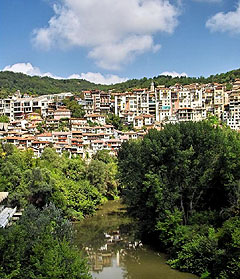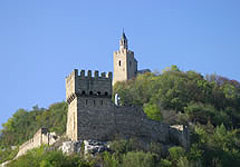Bulgaria has many enchanting and fascinating regions but Turnovo is one of those places that “must be seen to be believed”. It seems like a holdover from earlier decades, retaining unspoiled beauty and bygone-era charm. Nestled in the mountain region and built on the side of hills along the awesome Yantra, Turnovo is surrounded by antiquity and is fairy tale city. Here history rears up and slaps you in the face everywhere you go. Miles before you get into the city, the ruins of the ancient protective wall can be seen guarding the city. Here is where the magic begins. The mystery of other times embraces the visitors and leads them throughout the entire city. The king’s palace, churches, house-museums, the citadel, and the sculptures that adorn them are a catalog of fourteen centuries of artistic styles.
The city has been clearly divided into three parts; The Medieval, Revival, and Modern. All three represent the historical development and cultural heritage from the forth millennium BC until today. The medieval town of Turnovo was the capital of Bulgaria from the 12th to the 14th centuries. It was erected on the Tzarevetz Hill behind a massive fortress. Mystical atmosphere haunts the town and the King’s palace. The stones and the ruins whisper legends. The perpetual breeze wipes away the unexplained tears. One leaves the city with an appreciation of the knowledge gained.
The rugged and rocky terrain Yantra River and the independent Bulgarian national spirit formed Revival town. Inns, storehouses, shops and the marketplaces, constructed by the master-builder Nicola Fitchev and his students, cheer up everybody with its nineteenth century atmosphere. The streets are narrow and steep. Some of them are just endless stairs. The houses are two to three floors tall, and the first floor being made of stones with no windows. A heavy door, nailed with iron hinges, is designed to protect the family from invaders of the Ottoman Empire. The second and third floors have as many as four windows on the front exterior wall. Bulgarians enjoy the daylight with a clear view of the local mountains. The houses are ornamented with birds and flowers on the arches. Each room has its own unique wood carving on the ceiling.
In the modern part of the city, the wide streets are lined by high rise apartment buildings. The wail of horns, the screaming of brakes, and the wafting of aromas from the many restaurants, snaps you back to reality. Along with the old master’s traditions, the Turnovo University, the Palace of Sports, the Dramatic Theater and other splendid sites were developed with the goal of blending the old with the new. As in most European countries, Bulgarian cities can hardly be understood outside of the context of a nation’s history.
Determined by its location, colored by the history and blessed by its bright population, Turnovo is reborn new and different with each of its four seasons. The coming of spring closes firmly the door of winter. The small flower gardens of each home, the plants on every window, the greenery of the hills and the merry song of Yantra open the gates of the summer. The biggest Bulgarian craft market and countless cultural events attract visitors until the end of September. Autumn will then paint its picturesque surroundings in red, gold, and brown. Heavily loaded horse-carts carry to the food market the abundance from many villages. The women hang up multicolored woven rags to capture the warmth of the sun’s last rays. The rich black earth plowed up and ready to swallow the seeds, releases a pungent aroma under quiet rains. Everybody and everything is in a final dance before the long, sedative winter. November covers Turnovo with a white blanket. It is the time for savoring homemade bakeries and sausages that are crying for a glass of rich red wine. Folk songs and fairy tails fill the nights. It is the season of the craftspeople, putting their talents, skills and dreams into pottery, wood carvings, copper and silver, frescoes and icons, textile craft and embroidery that will bloom on the market with the first song of spring.
Turnovo has much to be proud of. Best are the people that preserve the pure Bulgarian spirit. They are the fortresses and the guards of the national traditions.
Their firm grasps, when shaking hands, reveal sincerity, dignity and
pride of being part of the most beautiful and unique city. It is no wonder
they call the city “Veliko Turnovo” which means “The Great Turnovo”.
By Daphne Karcheva-Orris


Veliko Turnovo
Bulgaria
